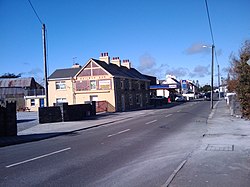Lixnaw
| Lixnaw Irish: Leic Snámha | |
| County Kerry | |
|---|---|

| |
| Location | |
| Location: | 52°24’7"N, 9°36’58"W |
| Data | |
| Population: | 248 (2001) |
| Post town: | Lixnaw |
| Postcode: | V92 |
| Local Government | |
| Council: | Kerry |
Lixnaw is a village in the north of County Kerry. It is located near the River Brick, seven miles south-west of Listowel and 11 miles north-east of Tralee. Its name comes from the Irish Leac Snámha, meaning "swimming flagstone".[1]
History
Lixnaw was once the seat of the Fitzmaurice family, the Earls of Kerry. In 1320 Nicolas, the third baron of Lixnaw, erected the Castle of Lixnaw, built the old bridge, and improved the village. In 1600 Sir Chas. Wilmot and his forces garrisoned the castle and established it as their centre of operations. It was subsequently re-taken by Lord Kerry who entrusted its defense to his brother Gerald, who was eventually forced to surrender the castle due to a shortage of water.[2] Today, nothing remains of the Castle of Lixnaw. An interesting point about the Earls of Kerry is that one of the descendants William Petty, 2nd Earl of Shelburne, who was born in Dublin but was largely reared in Lixnaw (except when he was in Eton), became British Prime Minister in 1782. Later Lansdowne Road was named after him and it became the common name for that great rugby stadium in Dublin.
Lixnaw is situated near the River Brick over which there were originally two stone bridges, from which the village got its name.
Places of interest
The Korean War Memorial [1][2] Erected to honour the Irish soldiers who died in the Korean War. A total of twenty-nine Irishmen died while serving under conscription in the US Army under the banner of the UN from 1950-1953. The monument takes the form of a stone arch, 12 ft high and 17 ft wide with three granite slabs on which all 35 names, addresses and dates of death are inscribed. Due to the intricate layout of Lixnaw village, this memorial has proven to be very difficult to find, even for the locals.
St Michael's Church is a Roman Catholic church designed by architect J. J. McCarthy, but more Norman than Celtic in design, due to having to flank the nave with aisles that open off it through robust round arched arcades. Modernised interior.
St Michael's Holy Well features a statue depicting St Michael defeating Satan.
Transport
Lixnaw railway station opened on 20 December 1880, closed for passenger traffic on 4 February 1963, closed for goods traffic on 2 December 1974 and finally closed altogether on 11 June 1983.[3]
Sport
The local Gaelic Athletic Association club is Lixnaw GAA.
References
- ↑ http://www.logainm.ie/?text=Lixnaw
- ↑ Lewis, S (1837). Topographical Dictionary of Ireland.
- ↑ "Lixnaw station". Railscot - Irish Railways. http://www.railscot.co.uk/Ireland/Irish_railways.pdf. Retrieved 2007-11-03.